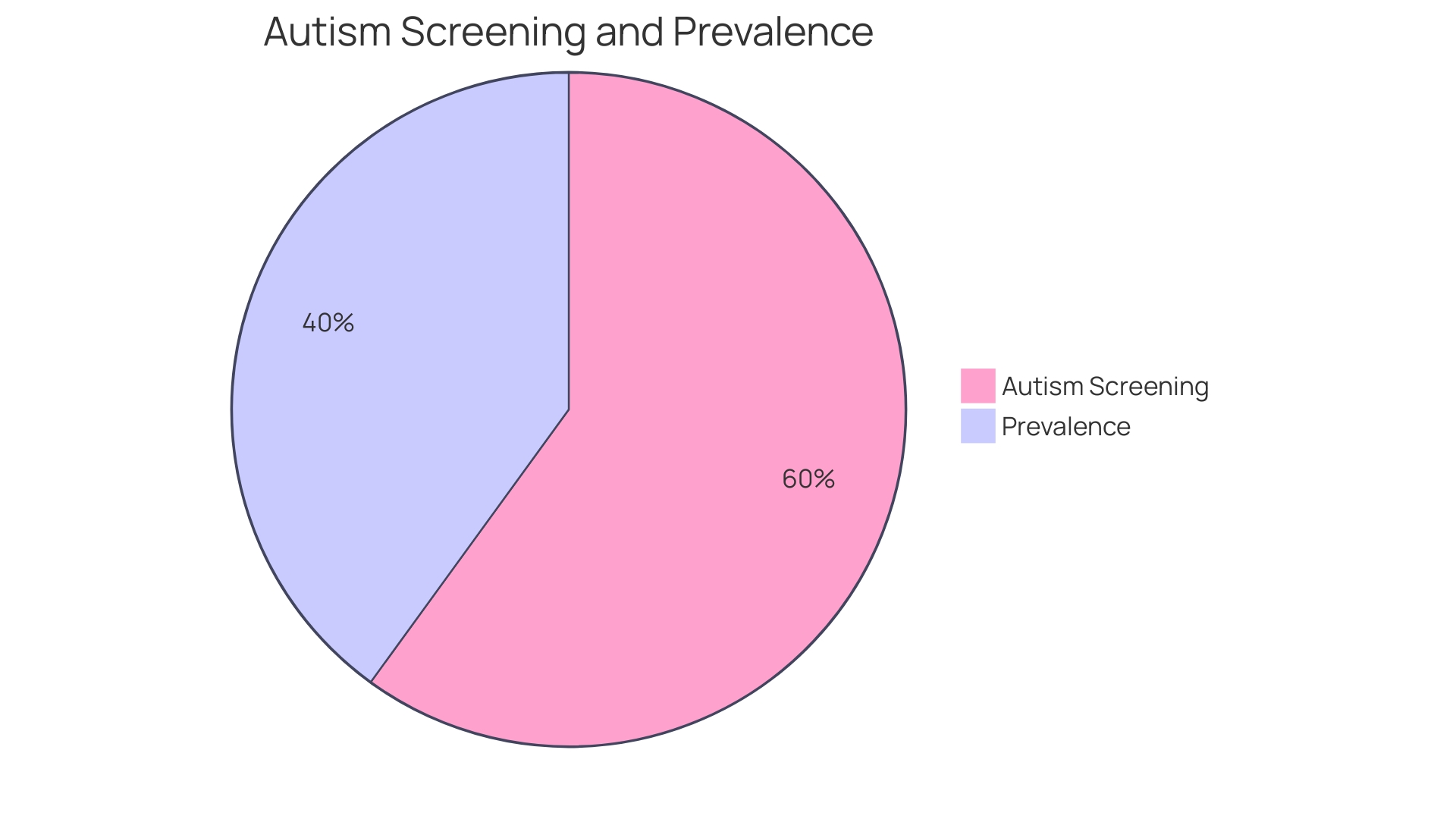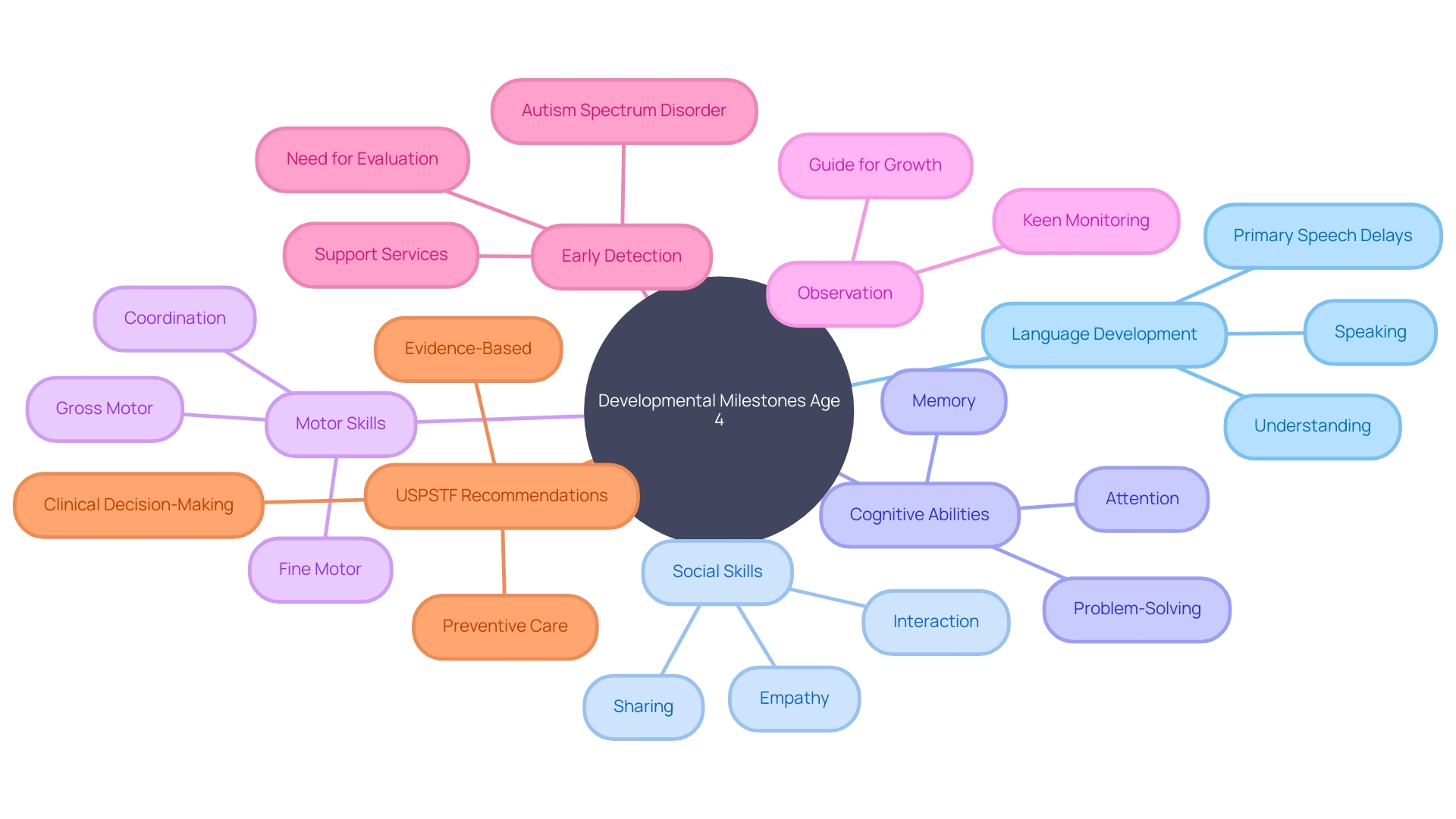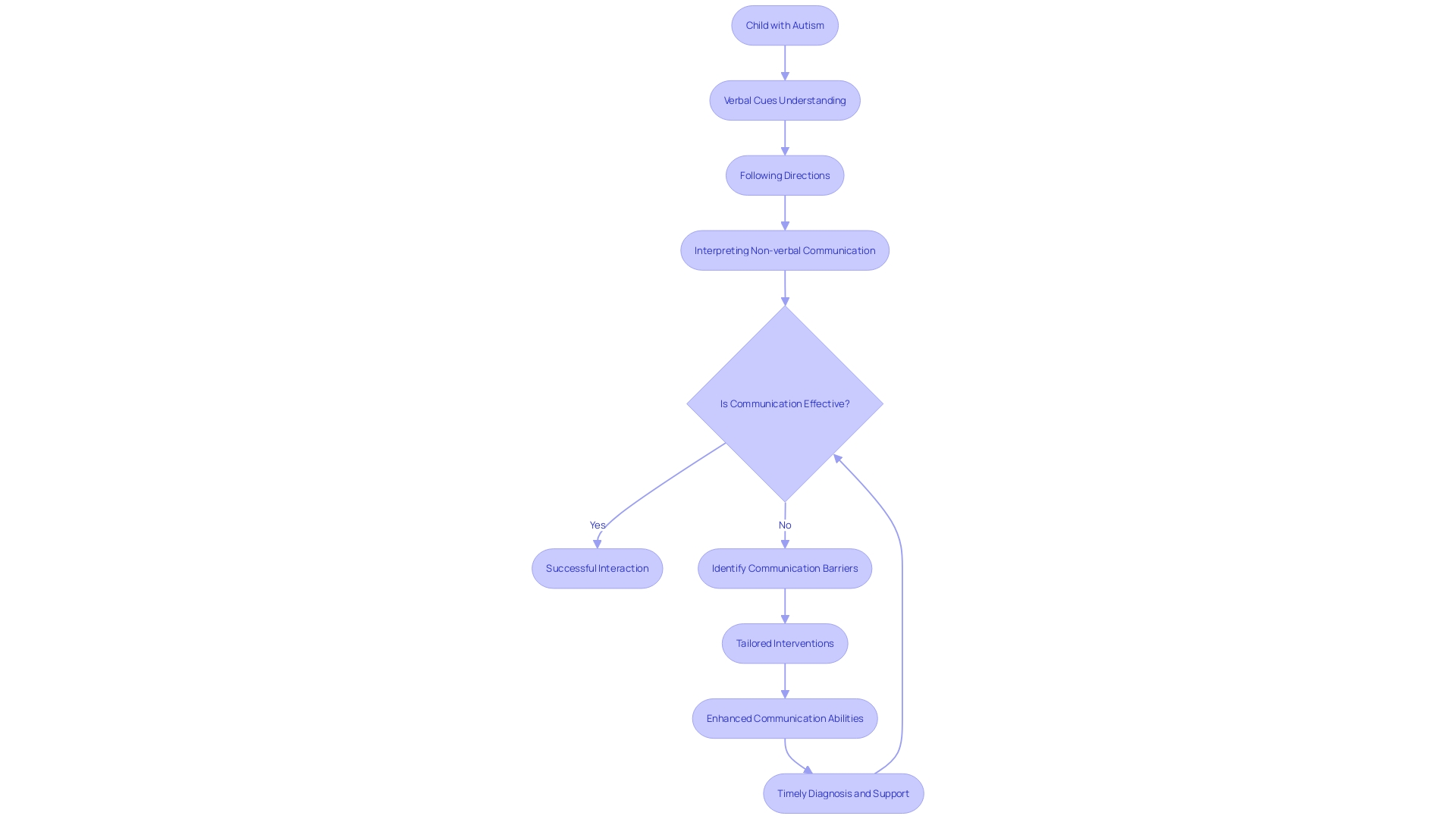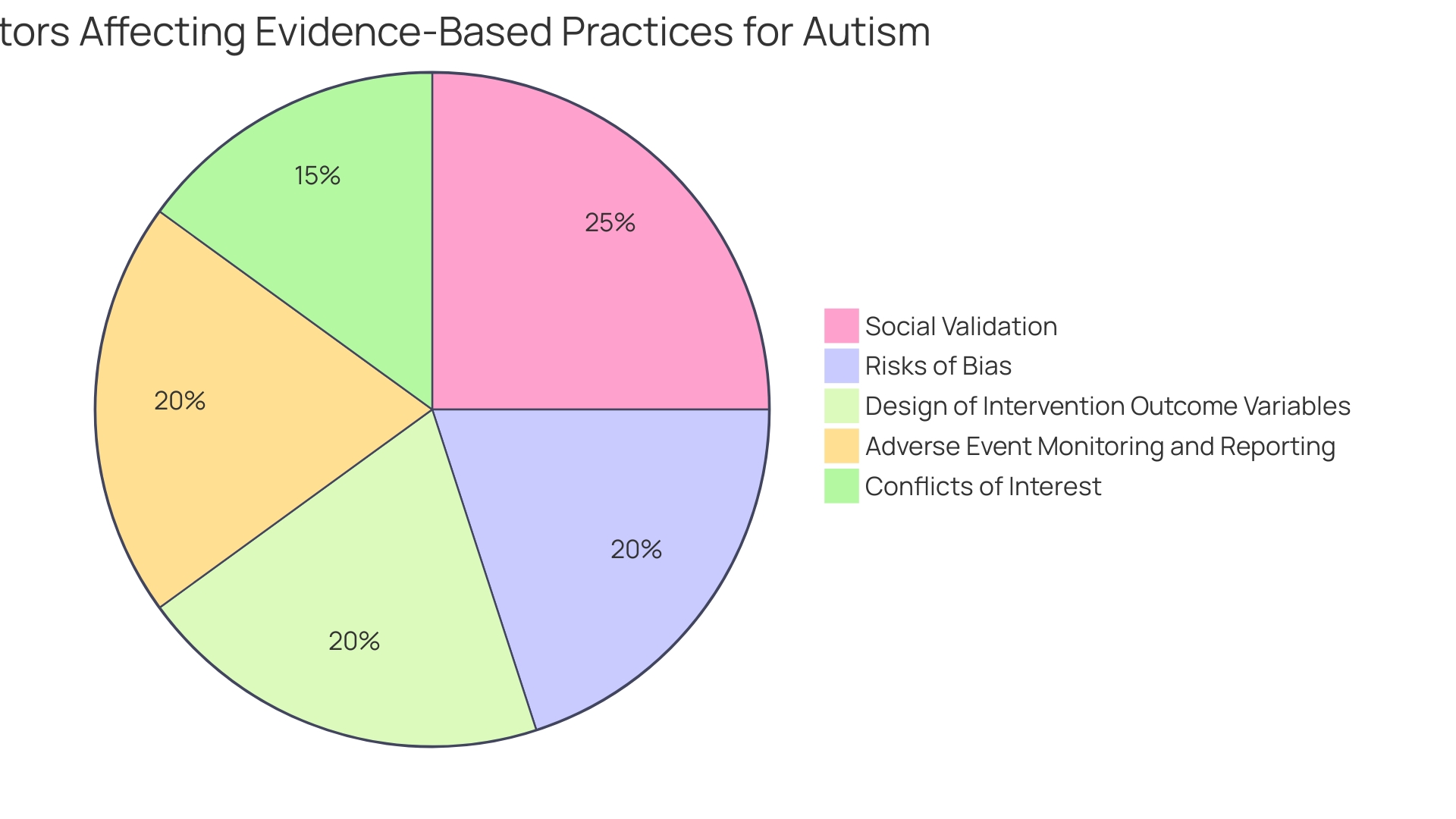Introduction
Autism Spectrum Disorder (ASD) is a complex neurodevelopmental condition that goes beyond challenges in social communication. It manifests differently in each individual, making early diagnosis crucial for better outcomes. Genetic and environmental factors influence its development, and advancements in technology, such as eye-tracking, offer new possibilities in early detection.
However, there is still a need for more efficient assessment processes to address the pressing challenges faced by individuals with ASD. Caregivers play a pivotal role in supporting children with autism, and staying informed and critical of information is essential. By fostering a collaborative effort, we can create an environment where every child with autism has the opportunity to thrive.
In this article, we will explore the nuances of autism, the key developmental milestones for 4-year-olds, challenges in social interaction and communication, repetitive behaviors and restricted interests, early warning signs of autism, and the importance of early identification and intervention. By understanding these aspects, we can empower parents and caregivers to navigate the journey of autism with confidence and provide the necessary support for the well-being of their children.
Understanding Autism Spectrum Disorder (ASD)
Autism Spectrum Disorder (ASD) is far more than just a challenge in social communication; it is a complex neurodevelopmental condition with a wide variation in how it presents in individuals. Children with ASD may show early signs through atypical social interactions, difficulties with communication, or repetitive behaviors. These nuances in behavior can be subtle and often require careful observation and professional evaluation to discern.
Recent studies emphasize the importance of early diagnosis, which can lead to early intervention and significantly better outcomes for children with ASD. The developmental trajectory of autism is influenced by a combination of genetic and environmental factors, and understanding these can be pivotal in addressing the condition effectively. Moreover, advancements in technology, such as eye-tracking, are heralding a new era of precision in diagnosing autism by identifying biomarkers early in a child's life.
However, despite these advancements, there is still a pressing need for more efficient and accurate assessment processes. This need is underscored by the reality that only a small fraction of children diagnosed with ASD before the age of 5 are able to live independently as adults. Intervention during infancy, when the brain's plasticity is at its peak, can be transformative in altering the course of the disorder.
It is essential for caregivers to stay abreast of the latest research and interventions, and to approach the information with a critical eye. Verifying sources and consulting with experts is crucial in navigating the myriad of information available online, including the diverse range of suggested treatments and medications for ASD.
Ultimately, it is the strength and capacity of those within a child's environment — the parents, teachers, and caregivers — that can make the most significant impact. Through a collaborative effort, focusing on the child's social, emotional, and mental health needs, we can foster an environment where every child with autism has the opportunity to thrive.

Key Developmental Milestones for 4-Year-Olds
As young minds grow, particularly around the age of 4, they hit numerous significant developmental benchmarks. These benchmarks span across various domains such as language development, where vocabulary burgeons and complex sentences form; social skills, with children learning to share and play cooperatively; cognitive abilities that include problem-solving and the beginnings of logical thinking; and motor skills, which see improvements in coordination and balance. It's at this pivotal stage that keen observation is crucial.
Developmental milestones serve as a guide to typical childhood growth and have implications in identifying atypical patterns, including those associated with autism spectrum disorder (ASD). Understanding these milestones not only celebrates growth but also acts as an early detection tool for conditions like ASD, highlighting the need for further evaluation and support.

Social Interaction Challenges
Children navigating the world with autism often face unique challenges in social interaction, which can be particularly evident in their ability to interpret social cues, sustain eye contact, and participate in back-and-forth conversations. This can manifest in a preference for solitary play over forming friendships, a sign that parents might recognize in their 4-year-old as indicative of autism. The late Dr. David (Dan) R. Offord, a renowned child psychiatrist, articulated the importance of creating an equitable 'race' for all children, including those with disabilities, by fostering environments that support their engagement at school, home, and in leisure activities, which is vital for their mental health and inclusion in society.
Autism Spectrum Disorder (ASD) is characterized by core difficulties in social communication and a tendency for repetitive behaviors or intense interests, sometimes accompanied by sensory sensitivities. A significant proportion of individuals with ASD also have co-occurring intellectual disabilities, highlighting the complexity of the condition and the need for tailored support and interventions. Early and accurate identification of ASD can lead to interventions that address not only the primary symptoms but also common co-occurring conditions like anxiety disorders, which can have a profound impact on their well-being.
Recent shifts in autism research from quasi-experimental studies to randomized controlled trials attest to the evolving landscape of intervention strategies. This rigorous approach aims to provide the most effective support possible for children with ASD and their caregivers. Yet, families often encounter systemic challenges when seeking support, a sentiment shared by both non-autistic and autistic parents, including those with their own autistic children.
Understanding the nuances of social communication, such as the differences between genuine and posed smiles, is just one aspect of the complex social world that children with autism must navigate. Interventions are increasingly being scrutinized for their long-term effectiveness, community acceptance, and transparency in reporting adverse events. With the right support, children with autism can flourish and contribute meaningfully to their communities while their families receive the necessary resources to support their development and overall family well-being.
Communication Difficulties
At the age of four, children are typically bustling with words and expressions, their communication blossoming as they approach the preschool years. However, for some children, particularly those on the autism spectrum, this developmental milestone may unfold differently. These young individuals might exhibit a narrower range of vocabulary and resort to simpler sentence structures, which can pose a challenge for those trying to decipher their intended meanings.
They might struggle with seemingly straightforward tasks like following directions or retaining information shortly after it's conveyed. These communication hurdles are not about a lack of effort to listen but rather a fundamental difficulty in processing verbal cues and responding appropriately.
Autism can also intertwine with other conditions, such as mental health challenges, which can complicate their ability to engage in care and conversations with others. It's essential to understand that effective communication is the bedrock of person-centered care and shared decision-making. When a child's speech and language development do not align with typical expectations, without the presence of another underlying condition, this is recognized as a primary speech or language delay.
Addressing these issues promptly can set the stage for more favorable outcomes.
The nuances of non-verbal communication, like interpreting gestures and facial expressions, can be equally bewildering for children with autism. This facet of communication is critical, as it often conveys more than words alone. The term Developmental Language Disorder (DLD) has been adopted by professionals and those with firsthand experience to acknowledge the profound impact these communication differences can have on daily life.
Diagnostic processes are intricate, necessitating a collaborative approach that takes into account the child's unique signs and symptoms. An accurate and timely diagnosis is paramount, as it opens the door to tailored interventions and support that can significantly enhance the child's life trajectory. Understanding these complexities is not just about recognizing signs; it's about ensuring that each child is heard, supported, and given the opportunity to thrive in their communication abilities.

Repetitive Behaviors and Restricted Interests
Recognizing the signs of autism in young children can be a pivotal step in securing early intervention. Among the core characteristics of autism spectrum disorder (ASD) are repetitive behaviors and restricted interests. It's not uncommon to see a child with autism demonstrating actions like hand-flapping or body rocking.
They might also show a profound and intense focus on certain topics or adhere strictly to specific routines. These behaviors, while perhaps perplexing, are indicative of how individuals with ASD may interact with their world and cope with sensory input.
Repetitive and restricted behaviors (RRBs) have always been part of human development, supporting neural growth and motor control from infancy. However, when these behaviors continue beyond the developmental periods where they serve a purpose, it can signal a potential neurodevelopmental disorder, like autism. In fact, research suggests that an elevation in RRBs could signify delays in more advanced cognitive mechanisms for controlling behavior and emotions.
Medical professionals use frameworks like the MOBSE approach, developed by Dr. Smile's team at Holland Bloorview, to assess medical and nutritional factors that might influence these behaviors. This is particularly important given that autistic children are four times more likely to experience gastrointestinal issues, which can exacerbate or even trigger RRBs.
Furthermore, studies harnessing advanced data analysis methods indicate that understanding these behaviors can lead to better predictions and interventions. For example, The Center for Discovery's use of AI and machine learning to analyze comprehensive data sets has shown promise in forecasting behaviors, which could allow for preemptive measures to be taken.
Despite the challenges in diagnosing ASD due to its complex nature and overlap with other conditions, ongoing debate and research strive to refine diagnostic criteria. This pursuit aims to distinguish ASD more clearly and accurately, ultimately enhancing our understanding and support for children showing these early signs.

Early Warning Signs of Autism in 4-Year-Olds
For parents, noticing early signs of autism in young children, such as a 4-year-old, can be the first crucial step towards seeking intervention that could markedly influence their child's life trajectory. Recognizing signs such as challenges with social engagement, delayed speech or language milestones, repetitive movements, or insistence on sameness can galvanize parents to seek evaluation and support. Dr. David (Dan) R. Offord's analogy of life being a race underpins the importance of equitable opportunities for every child, including those with autism.
As such, understanding and acting upon these early indicators of autism is not just about medical diagnosis; it's about fostering a fair start in life, enabling all children to participate fully in societal domains like school and community activities.
Indeed, the early identification of autism is pivotal for intervention at a time when a child's development is most malleable, potentially altering the course of their growth and minimizing the impact of associated disabilities. The urgency for early and accurate diagnostic tools is echoed by organizations like The Autism Community in Action (TACA) and NeuroQure, which strive to support families from the earliest stages possible. With research suggesting that early behavioral therapy can substantially improve outcomes for children with autism, the provision of timely diagnosis through innovative technologies such as eye-tracking and machine learning models like the 'AutMedAI' becomes even more critical.
The quest for more accurate and efficient assessment processes is also highlighted by the variability in current screening practices, such as the Modified Checklist for Autism in Toddlers-Revised with Follow-Up (M-CHAT-R/F). The tool's efficacy varies across different settings and demographics, underscoring the need for scalable and objective screening methods. Moreover, the American Academy of Pediatrics emphasizes the concept of a family-centered medical home, which includes comprehensive care coordination and developmental monitoring, to ensure that all needs of a child with autism are met, further reflecting the significance of early and integrated approaches to autism care.
Red Flags in Social Interaction
Autism Spectrum Disorder (ASD) presents in a highly heterogeneous manner, making the diagnosis a nuanced and complex task reliant on clinical judgment. The detection of autism-related behaviors is often through direct observation and informant report, which can lead to delayed access to crucial therapeutic supports for many young children and their families. The need for more accurate and efficient assessment processes is evident, especially during infancy, to leverage the high plasticity of the developing brain and prevent the entrenchment of associated disabilities.
The current screening method at 18–24-month well-child visits, the Modified Checklist for Autism in Toddlers-Revised with Follow-Up (M-CHAT-R/F), has shown discrepancies in accuracy between research settings and real-world primary care, especially for girls and children of color. With a high specificity rate of 95% but a low sensitivity of 39%, the M-CHAT-R/F's positive predictive value stands at 14.6%, underscoring the dire need for more precise and scalable screening tools. These tools could potentially reduce disparities in access to early diagnosis and intervention, improving outcomes for children with autism.
Emerging technologies such as eye-tracking are paving the way for more objective and accurate early identification of autism by capturing the visual attention differences that are often seen in individuals with ASD. This technology can offer insights into the development of autism in early childhood, and when coupled with the latest research studies, can guide clinicians in choosing the most effective interventions. The shift from quasi-experimental studies to randomized-controlled trials in autism research further supports the application of evidence-based practices.
The landscape of autism interventions is diverse, with a range of options available. Yet, the best support strategy remains a topic of debate among researchers. It is critical for intervention providers to consider risks of bias, social validation, design of outcome variables, adverse event monitoring, and conflicts of interest when offering evidence-based practices to support people with autism.
This comprehensive approach ensures the delivery of interventions that are not only effective but also meaningful and well-received by the community.

Red Flags in Verbal Communication
When observing a 4-year-old's communication abilities, certain signs may suggest the need for a closer look at their language development. These signs can include a noticeable lag in speech milestones, a limited range of vocabulary compared to peers, challenges in grasping and executing given instructions, and a tendency to echo words or phrases, a behavior known as echolalia. Such symptoms not only affect a child's ability to express themselves but also their interaction with the world around them.
They may seem inattentive or forgetful, potentially leading to misunderstandings. Developmental Language Disorder (DLD) is a term often used to describe significant and ongoing difficulties in learning and using language, and it is essential for families and professionals to use a shared language when discussing these challenges. Early recognition of these signs is critical as it enables parents to seek necessary evaluations and interventions.
This can lead to better support for the child, ensuring their communication needs are understood and met.
Red Flags in Repetitive Behaviors and Sensory Sensitivities
For 4-year-olds, the emergence of repetitive behaviors and unique sensory responses can be key signs of autism spectrum disorder (ASD). These children may exhibit actions like hand-flapping or spinning, and have pronounced reactions to sensory inputs such as sound or texture. They might also show considerable difficulty when faced with alterations in their routines.
Recognizing these signs is crucial because according to the CDC, ASD affects as many as 1 in 36 individuals. The American Psychiatric Association's DSM-5 highlights these restricted and repetitive behaviors alongside persistent differences in social interaction as diagnostic indicators for ASD. Understanding and identifying these behaviors early can lead to timely interventions, which can significantly improve outcomes, as the brain's plasticity is at its peak during the early years.
Research has debunked myths linking ASD to vaccines or parenting styles, pointing instead to brain structure or function differences, with genetics playing a possible role. Organizations like The Autism Community in Action (TACA) and innovative biotech startups such as NeuroQure are working towards early detection and treatment, underscoring the importance of early and accurate diagnosis for living a full life despite ASD.
Distinguishing Between Typical Development and ASD
Recognizing the unique developmental journey of a child with Autism Spectrum Disorder (ASD) is crucial. ASD is not a condition that one outgrows or that needs 'curing'; it's a fundamental aspect of a person's makeup, influencing their perception and interaction with the world. Unlike typical development, which follows a predictable pattern, ASD presents in a spectrum, with each individual experiencing it distinctively and to varying degrees of severity.
Some may possess remarkable abilities, such as intense focus, meticulous attention to detail, and exceptional problem-solving skills, which are particularly beneficial in fields like technology.
Parents should be aware of developmental milestones, including social, emotional, and cognitive skills, to monitor their child's progress. If a child displays atypical behaviors or misses milestones, it may signal the need for a thorough evaluation. Diagnosing ASD involves a combination of parental insights and professional observation, with tools guided by the American Psychiatric Association's DSM-5, although no single tool should be used in isolation for diagnosis.
In some instances, referral to specialists like neurodevelopmental pediatricians or child neurologists may be necessary for further assessment.
Recent scientific advancements, such as the development of sophisticated organoid models to study the cerebellum and breakthroughs in understanding the role of neurotransmitters like dopamine in autism, continue to shed light on the condition. Artificial intelligence is also emerging as a potential aid in early diagnosis. These developments, coupled with appropriate interventions and support systems, can significantly enhance the lives of individuals with ASD and their families.
Understanding and embracing the intricacies of autism is the first step towards nurturing the unique talents and addressing the challenges that come with it.
Importance of Early Identification and Intervention
Identifying Autism Spectrum Disorder (ASD) at the earliest possible stage is paramount for initiating interventions that can significantly enhance developmental trajectories, particularly in areas like language and social skills. The process of recognizing ASD can be intricate and variable, relying heavily on clinical judgment through direct observation and informant accounts. The variability in behavioral presentation means that the road to diagnosis and access to essential support services can be lengthy, which is particularly detrimental during the formative years when the brain's plasticity is at its peak.
Traditional screening methods, such as the Modified Checklist for Autism in Toddlers-Revised with Follow-Up (M-CHAT-R/F) administered during well-child visits, do show promise but face challenges in real-world application. They can be less effective for certain demographics, including girls and children of color, and may suffer from low follow-up rates by pediatricians, leading to disparities in early diagnosis and intervention. The development of innovative, objective, and scalable tools for autism screening is therefore critical.
Notably, advances in technology are showing great potential to enhance diagnostic accuracy and efficiency, moving beyond the limitations of solely relying on the expertise of individual clinicians.
Eye-tracking technology is emerging as a powerful method, providing objective insights into the early emergence of autism. Furthermore, a groundbreaking study utilizing a substantial dataset has led to the development of machine-learning models, without Media showing an impressive 80% accuracy rate in identifying children with autism. This fusion of modern technology and traditional observational practices represents a new frontier in early ASD detection, offering hope for more timely and equitable support for children and their families.
Seeking Professional Evaluation and Support
When parents notice developmental concerns in their 4-year-old, such as potential signs of autism, taking action is crucial. It's recommended to consult with specialized healthcare providers, like developmental pediatricians or child psychologists, who can administer a thorough evaluation to ascertain if the child fulfills the diagnostic criteria for autism spectrum disorder (ASD). This professional assessment is the gateway to acquiring suitable interventions and services that can significantly impact the child's ability to engage meaningfully in school, home, and recreational activities, which are pivotal to their mental health and overall well-being.
As Dr. David (Dan) R. Offord, a renowned child psychiatrist, once stated, "I do not mind if my children are in a race as long as the race is fair." Ensuring equitable opportunities for children with autism means acknowledging their unique strengths and addressing their specific needs, alleviating persistent stressors, and empowering caregivers with the necessary tools to nurture their children's growth. With ASD affecting 1 in 70 individuals and a significant portion also experiencing intellectual challenges, the stakes are high for creating inclusive environments that foster participation and equity.
Moreover, staying informed about the latest advancements in autism understanding and interventions can help parents make informed decisions about their child's care. This ongoing education is vital, as highlighted by the voices of those entrenched in the autism community, who emphasize the importance of comprehending the benefits and potential side effects of treatments and maintaining vigilance over their child's response to any interventions.
Current initiatives, such as those by the Interagency Autism Coordinating Committee (IACC) and various stakeholders, are working to enhance the coordination of autism research and services. Their efforts aim to break down barriers and improve the employment prospects and quality of life for individuals with autism. Keeping abreast of these developments can empower caregivers to advocate for and support their children's journey through life with autism.
Conclusion
In conclusion, Autism Spectrum Disorder (ASD) is a complex neurodevelopmental condition that requires early diagnosis and intervention. Genetic and environmental factors influence its development, and advancements in technology offer new possibilities in early detection. Caregivers, particularly Parent Advocates, play a pivotal role in supporting children with autism by staying informed and providing necessary support.
Understanding key developmental milestones for 4-year-olds is crucial for identifying early signs of ASD. Challenges in social interaction and communication are common for children with autism, and addressing them early through tailored support is essential for their well-being. Recognizing repetitive behaviors and restricted interests is also important for early identification.
Seeking professional evaluation and support is crucial when developmental concerns arise in 4-year-olds. Specialized healthcare providers can administer thorough evaluations and provide suitable interventions and services. By staying informed about the latest advancements in autism understanding and interventions, Parent Advocates can make informed decisions and advocate for their children's needs.
In conclusion, by understanding the nuances of autism and staying informed, Parent Advocates can navigate the journey of autism with confidence and provide the necessary support for their children's well-being. Through a collaborative effort, we can create an environment where every child with autism has the opportunity to thrive.




